Journal list menu
Export Citations
Download PDFs
Cover Picture
Carbon Microstructure Dependent Li-Ion Storage Behaviors in SiOx/C Anodes (Small 25/2023)
- First Published: 21 June 2023
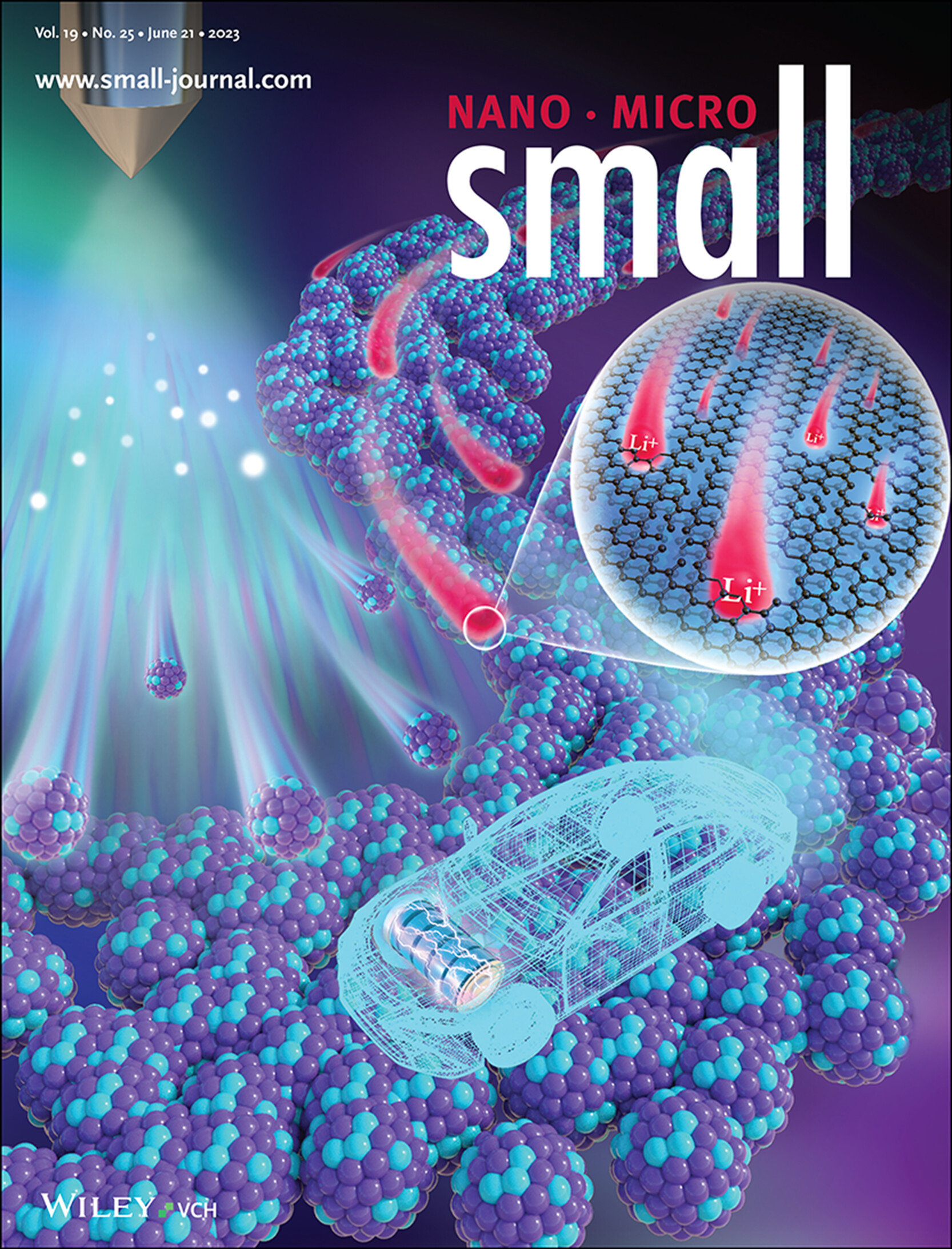
Lithium-Ion Batteries
In article number 2300759, Shang Wang, Hongbin Liu, Yanhong Tian, Lijie Ci, and co-workers report on the effect of carbon microstructure on the lithium-ion storage behaviors of SiOx/C anode. The authors study the disorder-of-carbon dependent Li-ion storage behavior in SiOx/C anode through a series of quantitative calculations and in situ X-ray diffraction (XRD) characterizations. This work reveals the important role the carbon microstructure plays in concurrent and sequential Li-ion storage, providing reference for the match optimization of SiOx/C anode materials.
Inside Front Cover
Generalized Encapsulations of ZIF-Based Fe–N–C Catalysts with Controllable Nitrogen-Doped Carbon for Significantly-Improved Stability Toward Oxygen Reduction Reaction (Small 25/2023)
- First Published: 21 June 2023
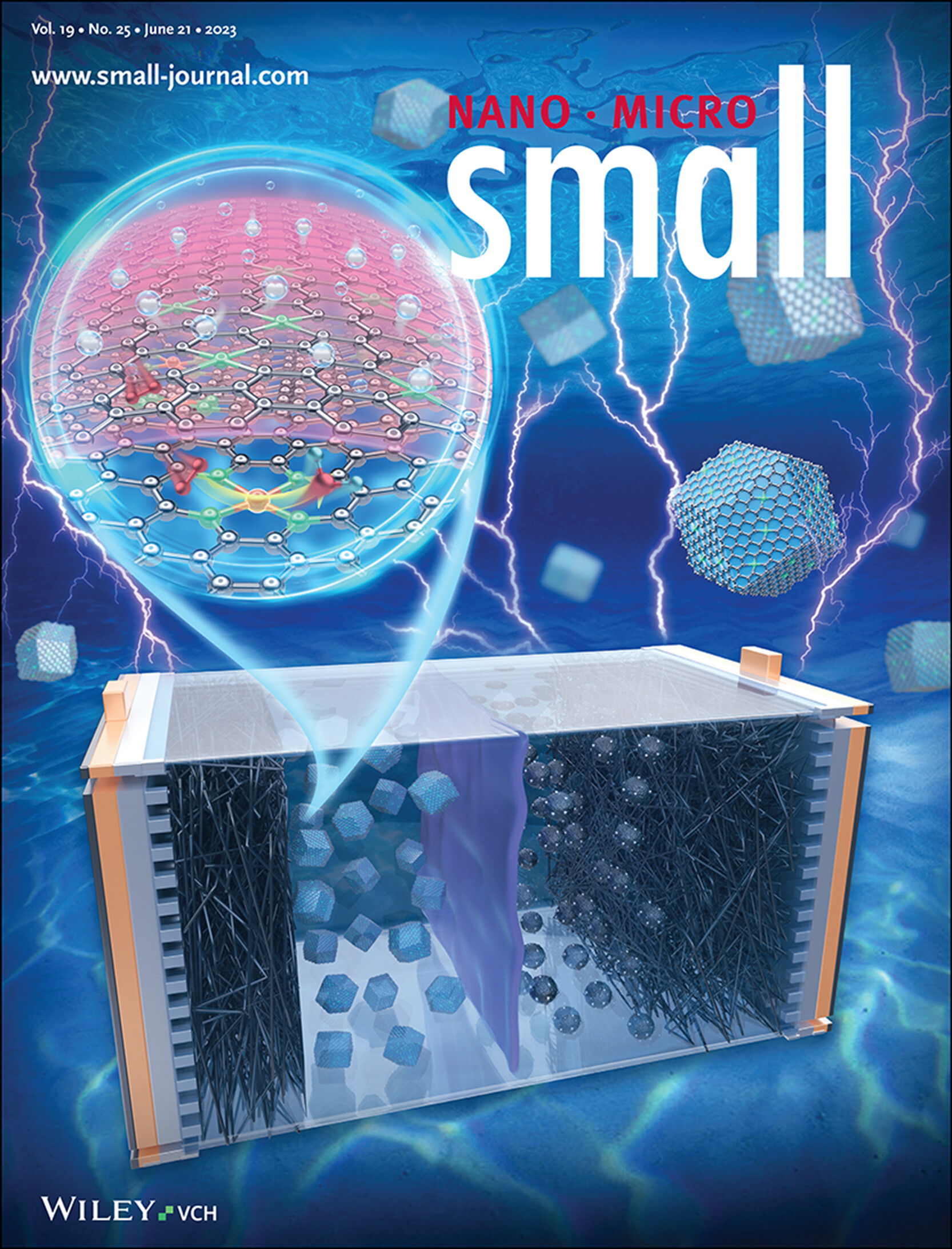
Fe–N–C Catalysts
In article number 2207671, Jia Li, Jianguo Liu, and co-workers develop a highly-catalytic Fe–N–C catalyst with a power density of >1 w cm−2 and prolonged lifetime (>40 h) using a controllable and efficient N–C coating strategy. The authors investigate the correlation between coating thickness and electrochemical performance. They also identify the stability improvement mechanism to the reduced carbon corrosion and iron loss in catalyst.
Inside Back Cover
Sintering Metal–Organic Framework Gels for Application as Structural Adhesives (Small 25/2023)
- First Published: 21 June 2023
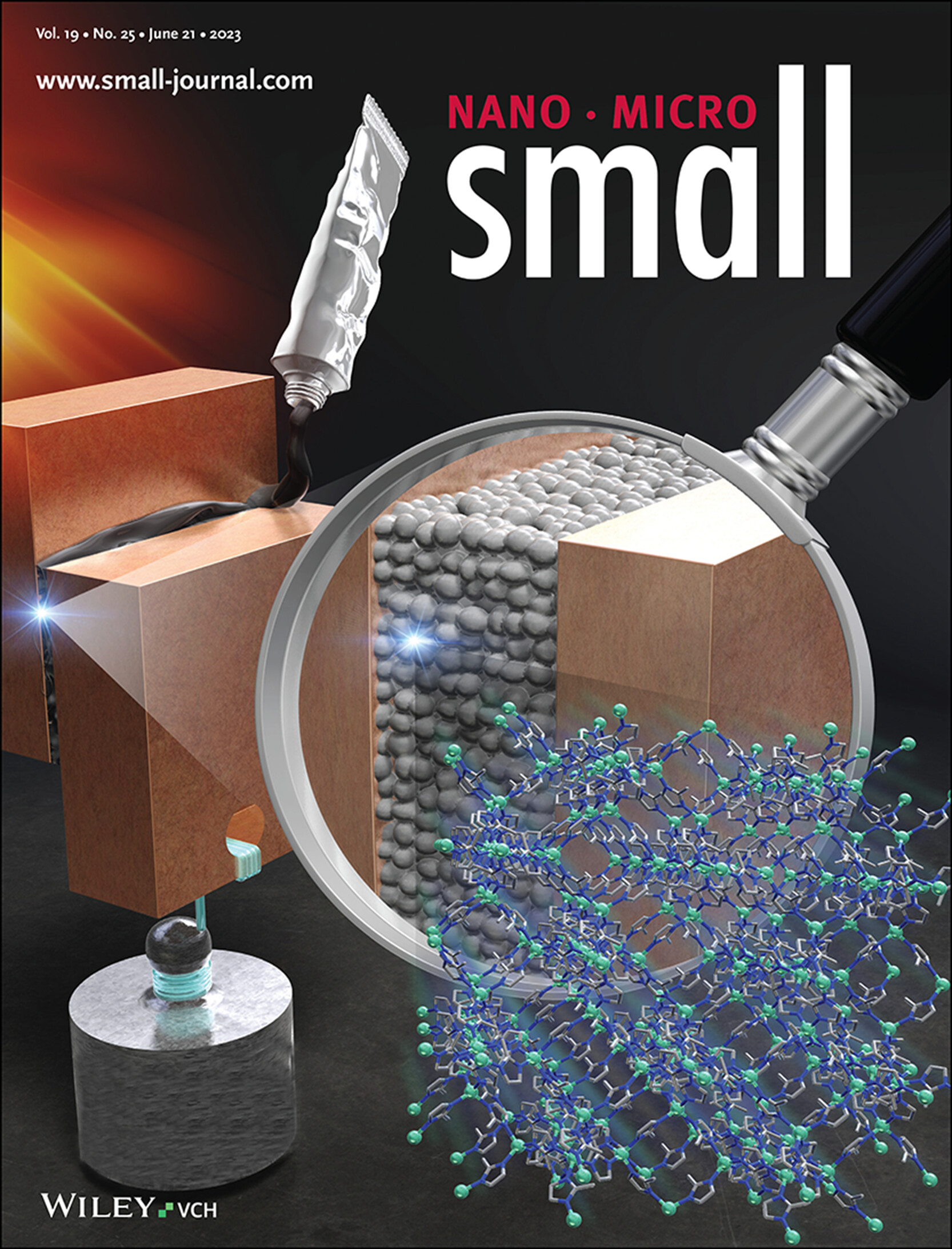
Metal–Organic Frameworks
The zeolitic imidazolate framework-67 (ZIF-67) gel sintering technique provides a microstructure of densely aggregated, large spherical ZIF-67 crystals, resulting in bonding of Cu substrates with shear strength exceeding 30 MPa, comparable to that of conventional structural adhesives. More details can be found in article number 2300298 by Izuru Miyazaki, Mitsutaro Umehara, and co-workers.
Back Cover
A Novel Aqueous Asymmetric Supercapacitor based on Pyrene-4,5,9,10-Tetraone Functionalized Graphene as the Cathode and Annealed Ti3C2Tx MXene as the Anode (Small 25/2023)
- First Published: 21 June 2023

Asymmetric Supercapacitors
Pyrene-4,5,9,10-tetraone (PYT) molecules are noncovalently combined with two different types of graphene (GN and LO). The electrochemical performance of the PYT/GN composites is found to be significantly better than the LO-based composites. When matched with an annealed Ti3C2Tx MXene anode, the assembled asymmetric device (PYT/GN 4–5//A-Ti3C2Tx) delivers an outstanding energy density of 18.4 Wh kg−1 at a power density of 700 W kg−1. More details can be found in article number 2301449 by Xiaoyan Zhang and co-workers.
Masthead
Reviews
Decellularized Extracellular Matrix for Remodeling Bioengineering Organoid's Microenvironment
- First Published: 16 March 2023
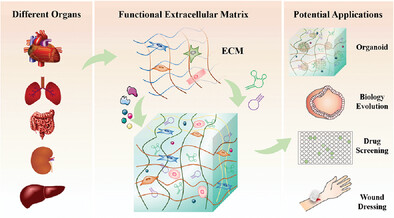
In this review, decellularization protocols and the characteristics of decellularization methods, the mechanical support and biological cues of extracellular matrix (ECM), methods for construction of multifunctional decellularized extracellular matrix (dECM) and responsive dECM hydrogel, and the potential applications of functional dECM are summarized. Also, some expectations are provided for dECM as the matrix of organoids in clinical applications.
Hybrid Nanogenerators for Ocean Energy Harvesting: Mechanisms, Designs, and Applications
- First Published: 16 March 2023
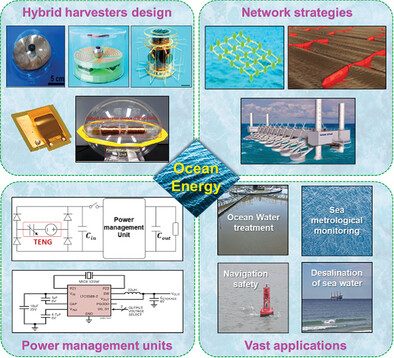
Nanogenerator-based ocean harvesting is a new technology that can generate electricity by harnessing the motion of ocean waves. It uses a nanogenerator to convert mechanical energy into electrical energy. This technology has the potential to produce renewable energy from the vast and powerful resource of the ocean, making it a promising solution for sustainable energy generation.
Metal-Organic Framework Materials in Perovskite Solar Cells: Recent Advancements and Perspectives
- First Published: 18 March 2023
Frontispiece
Tuning the Chiral Structures from Self-Assembled Carbohydrate Derivatives (Small 25/2023)
- First Published: 21 June 2023
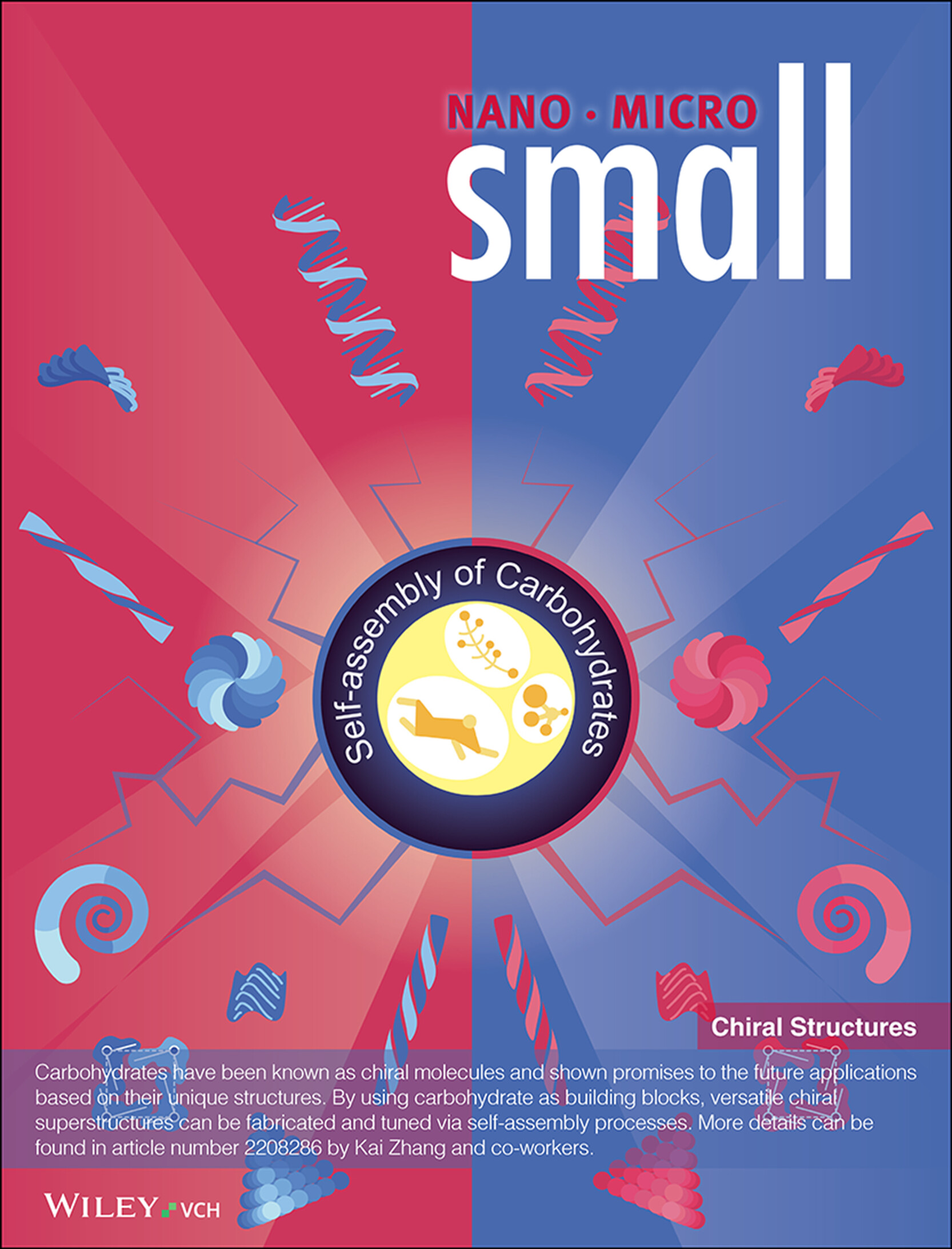
Chiral Structures
Carbohydrates have been known as chiral molecules and shown promises to the future applications based on their unique structures. By using carbohydrate as building blocks, versatile chiral superstructures can be fabricated and tuned via self-assembly processes. More details can be found in article number 2208286 by Kai Zhang and co-workers.
Reviews
Tuning the Chiral Structures from Self-Assembled Carbohydrate Derivatives
- First Published: 14 March 2023

Chirality exists in scales from as smaller as subatomic level through molecular and supramolecular level to even galaxy system. Carbohydrates have been known as chiral molecules and shown promises to the future applications due to their unique structures. Designing the corresponding chirality using carbohydrates is essential to their application in various fields, such as drugs and functional materials.
Frontispiece
Air- and Moisture Robust Surface Modification for Ni-Rich Layered Cathode Materials for Li-Ion Batteries (Small 25/2023)
- First Published: 21 June 2023
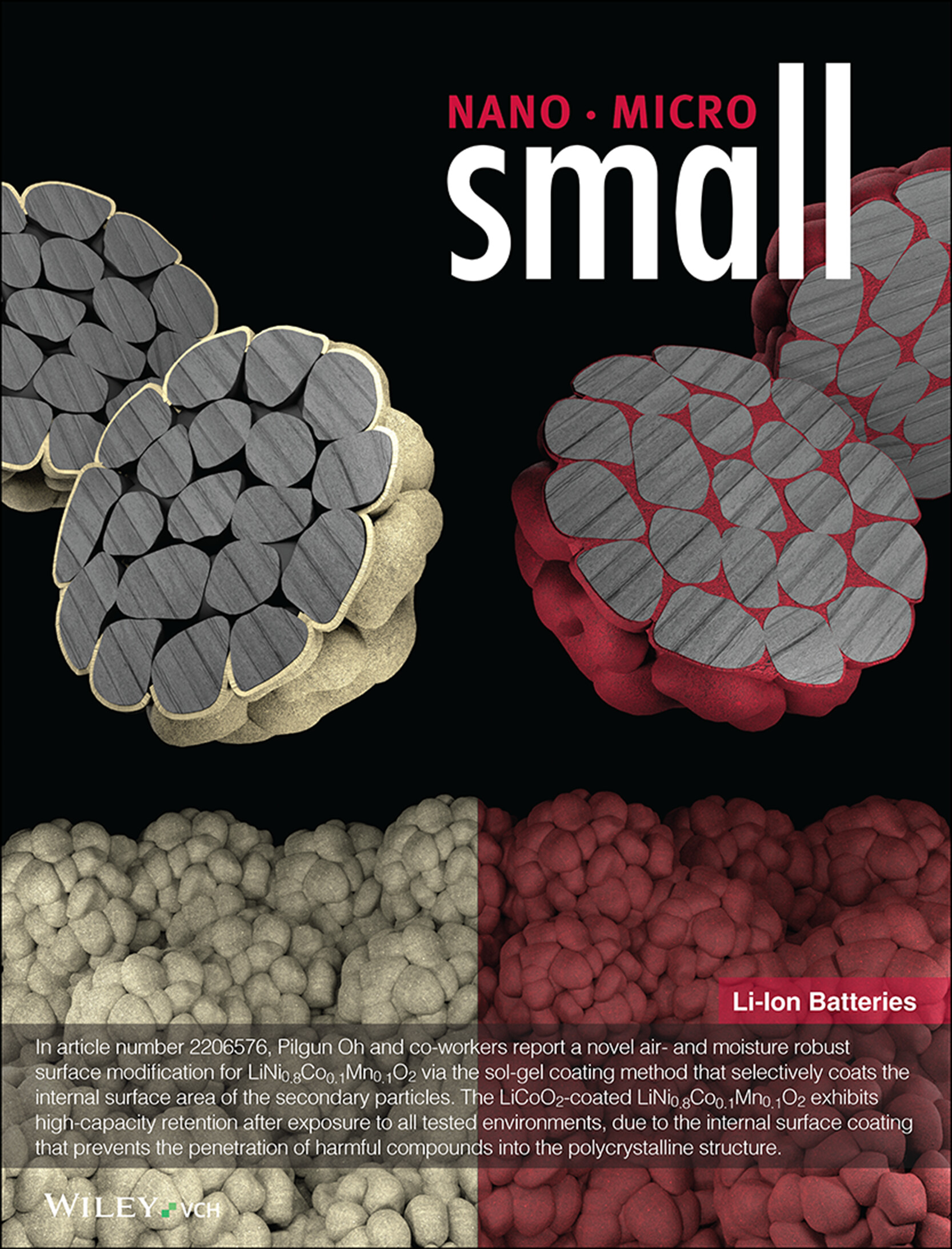
Li-Ion Batteries
In article number 2206576, Pilgun Oh and co-workers report a novel air- and moisture robust surface modification for LiNi0.8Co0.1Mn0.1O2 via the sol-gel coating method that selectively coats the internal surface area of the secondary particles. The LiCoO2-coated LiNi0.8Co0.1Mn0.1O2 exhibits high-capacity retention after exposure to all tested environments, due to the internal surface coating that prevents the penetration of harmful compounds into the polycrystalline structure.
Research Articles
Air- and Moisture Robust Surface Modification for Ni-Rich Layered Cathode Materials for Li-Ion Batteries
- First Published: 16 March 2023
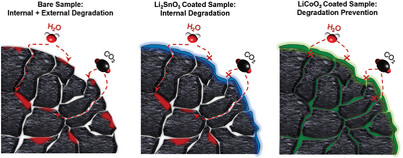
Ni-rich polycrystalline layered cathodes such as LiNi0.8Co0.1Mn0.1 (NCM811) are vulnerable to severe internal and external degradation from exposure to atmospheric environments. This work uncovers the importance of applying coating morphologies that protect the internal primary particles and the external secondary particles of NCM811 against this degradation, by comparing the results with purely secondary particle surface modification coatings.
Frontispiece
Structural Engineering of Hierarchical Aerogels Hybrid Networks for Efficient Thermal Comfort Management and Versatile Protection (Small 25/2023)
- First Published: 21 June 2023
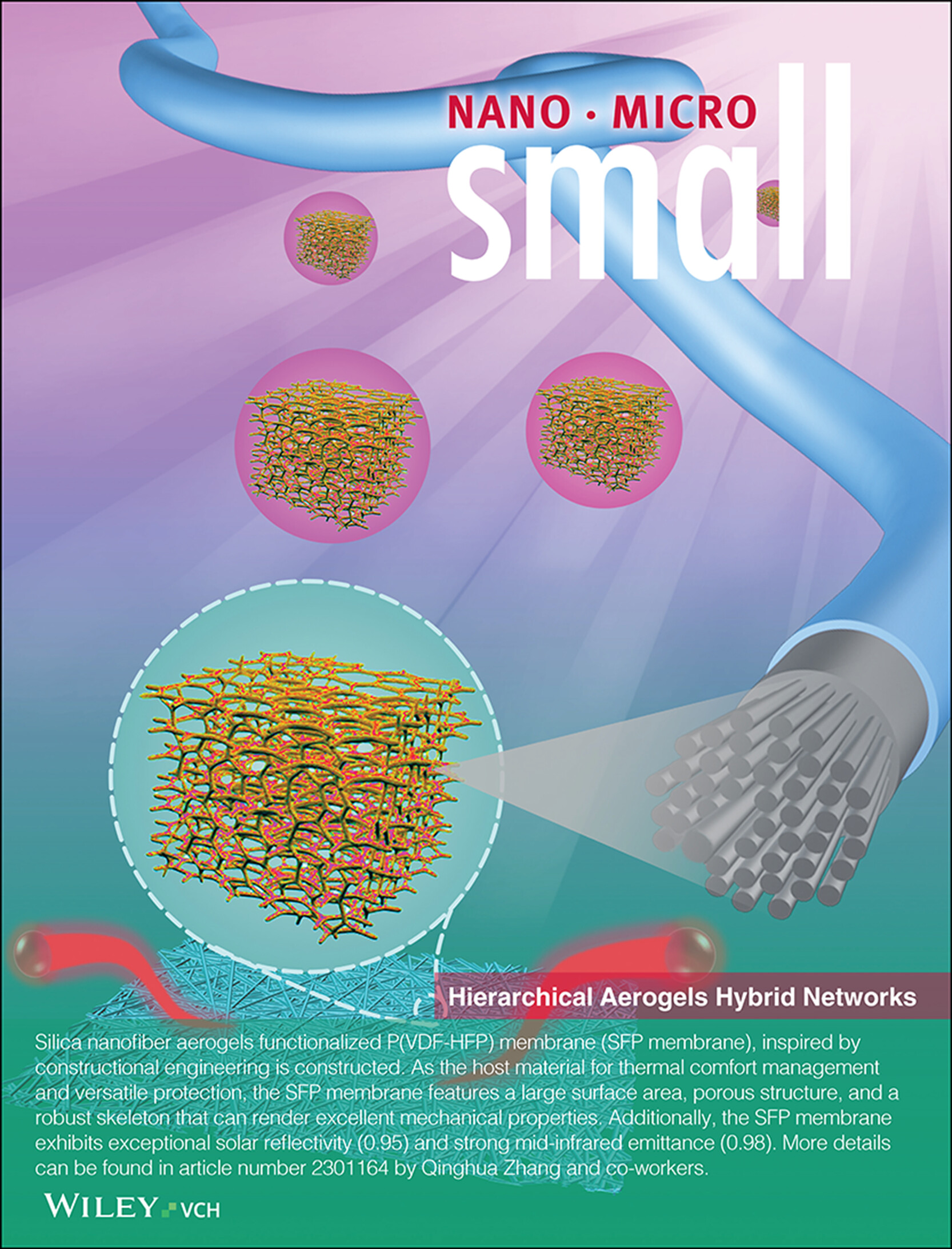
Hierarchical Aerogels Hybrid Networks
Silica nanofiber aerogels functionalized P(VDF-HFP) membrane (SFP membrane), inspired by constructional engineering is constructed. As the host material for thermal comfort management and versatile protection, the SFP membrane features a large surface area, porous structure, and a robust skeleton that can render excellent mechanical properties. Additionally, the SFP membrane exhibits exceptional solar reflectivity (0.95) and strong mid-infrared emittance (0.98). More details can be found in article number 2301164 by Qinghua Zhang and co-workers.
Research Articles
Structural Engineering of Hierarchical Aerogels Hybrid Networks for Efficient Thermal Comfort Management and Versatile Protection
- First Published: 15 March 2023
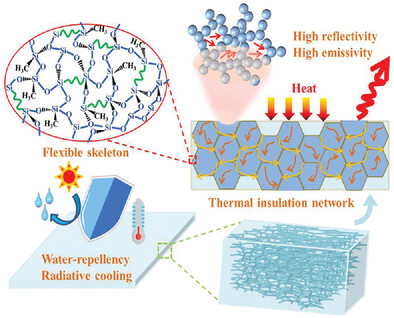
Hybrid membranes with flexible organic–inorganic network structure inspired by constructional engineering, which combines the hierarchical structure design and practicability principal for thermal comfort management (TCM) and versatile protection. The hybrid membrane combining silica nanofiber aerogels (SNAs) and flexible polymers, in which rubber-like Si−O−Si bonding networks that act as a high temperature nanochains. Particularly, hybrid membrane exhibits high reflectivity and strong MIR emissivity.
Frontispiece
A Selective Nano Cell Cycle Checkpoint Inhibitor Overcomes Leukemia Chemoresistance (Small 25/2023)
- First Published: 21 June 2023
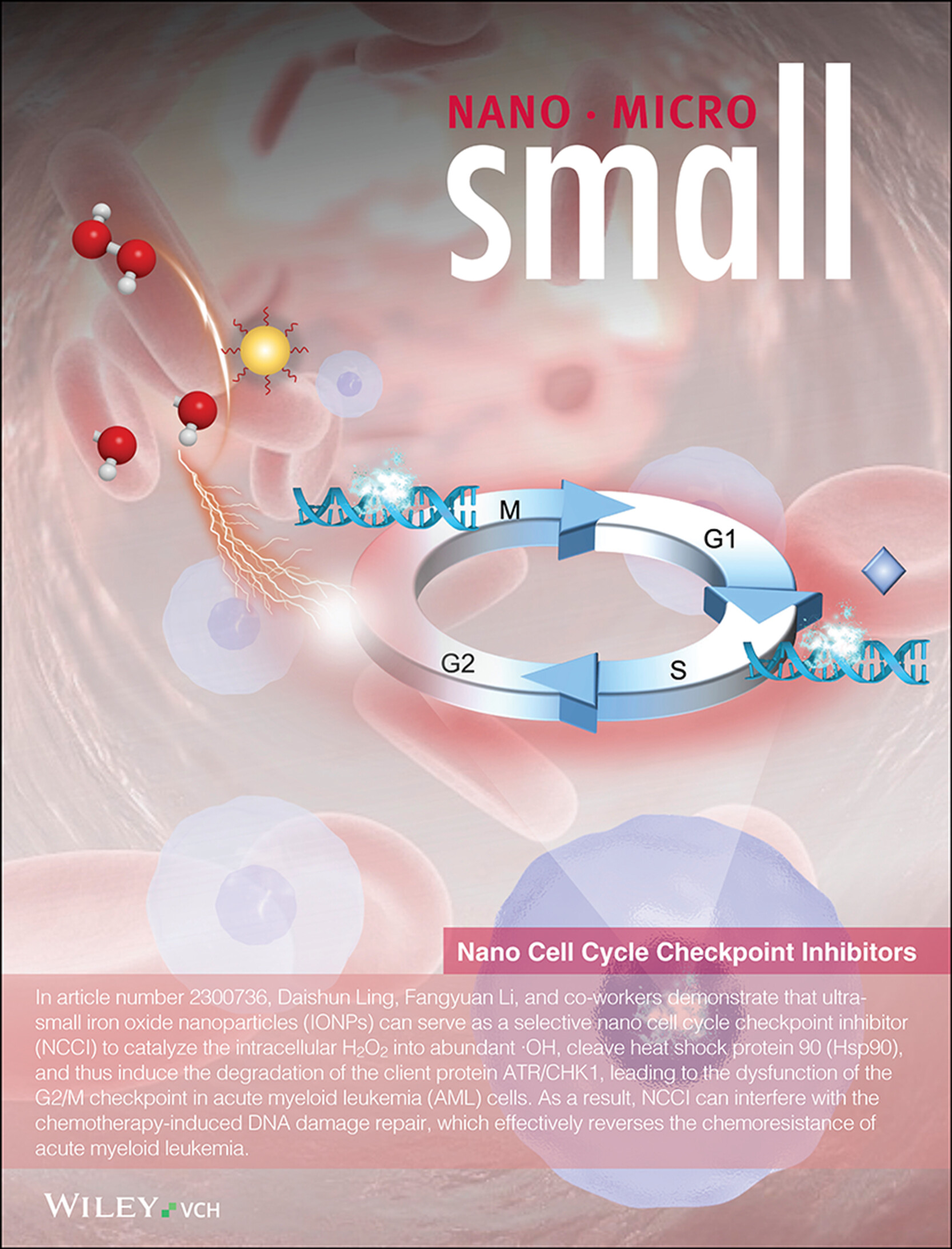
Nano Cell Cycle Checkpoint Inhibitors
In article number 2300736, Daishun Ling, Fangyuan Li, and co-workers demonstrate that ultra-small iron oxide nanoparticles (IONPs) can serve as a selective nano cell cycle checkpoint inhibitor (NCCI) to catalyze the intracellular H2O2 into abundant ·OH, cleave heat shock protein 90 (Hsp90), and thus induce the degradation of the client protein ATR/CHK1, leading to the dysfunction of the G2/M checkpoint in acute myeloid leukemia (AML) cells. As a result, NCCI can interfere with the chemotherapy-induced DNA damage repair, which effectively reverses the chemoresistance of acute myeloid leukemia.
Research Articles
A Selective Nano Cell Cycle Checkpoint Inhibitor Overcomes Leukemia Chemoresistance
- First Published: 08 April 2023
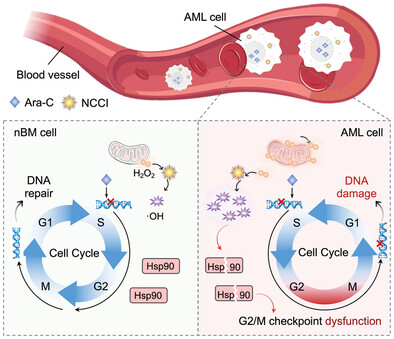
A selective nano cell cycle checkpoint inhibitor (NCCI: citric acid capped ultra-small iron oxide nanoparticles) is developed to boost the chemotherapeutic efficacy of genotoxic agents. After selectively accumulating in acute myeloid leukemia (AML) cells, NCCI converts H2O2 to •OH to induce the dysfunction of G2/M checkpoint, and thus eventually revitalizes the anti-AML efficacy of cytarabine by exacerbating DNA damage.
Carbon Microstructure Dependent Li-Ion Storage Behaviors in SiOx/C Anodes
- First Published: 15 March 2023
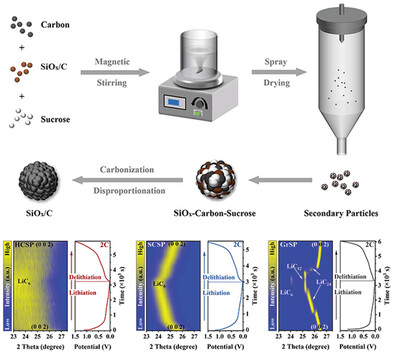
Through a series of quantitative calculations and in situ X-ray diffraction characterizations, the disorder-of-carbon dependent Li-ion storage behavior in SiOx/C anode was studied. This work reveals the important role the carbon microstructure plays in concurrent and sequential Li-ion storage, providing reference for the match optimization of SiOx/C anode materials.
Generalized Encapsulations of ZIF-Based Fe–N–C Catalysts with Controllable Nitrogen-Doped Carbon for Significantly-Improved Stability Toward Oxygen Reduction Reaction
- First Published: 03 February 2023
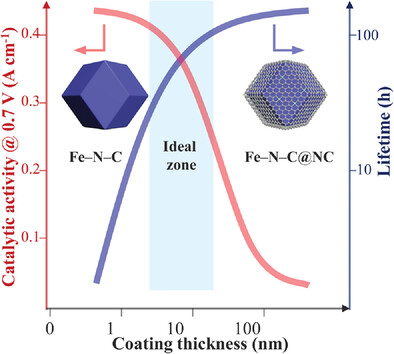
Development of highly-catalytic and long-term stable Fe–N–C catalyst using a controllable and efficient N–C coating strategy. The correlation between the thickness of N–C coatings and electrochemical performance is investigated. The stability improvement mechanism of N–C coating is identified to reduce carbon corrosion and iron leaching.
Sintering Metal–Organic Framework Gels for Application as Structural Adhesives
- First Published: 17 March 2023
A Novel Aqueous Asymmetric Supercapacitor based on Pyrene-4,5,9,10-Tetraone Functionalized Graphene as the Cathode and Annealed Ti3C2Tx MXene as the Anode
- First Published: 09 March 2023
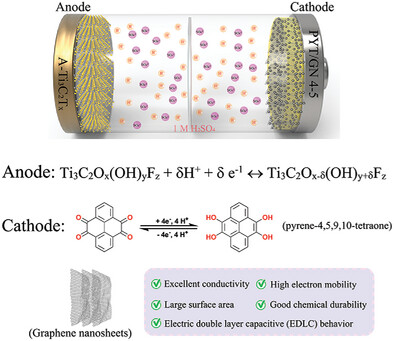
The pyrene-4,5,9,10-tetraone molecules are noncovalently combined with two different kinds of graphene (GN and LO). Compared with the LO-based composites, the PYT/GN composites show much better electrochemical performance. When matched with the annealed Ti3C2Tx MXene anode, the assembled asymmetric device (PYT/GN 4–5//A-Ti3C2Tx) delivers an outstanding energy density of 18.4 Wh kg−1 at a power density of 700 W kg−1.
Ultra-Highly Active Ni-Doped MOF-5 Heterogeneous Catalysts for Ethylene Dimerization
- First Published: 15 March 2023
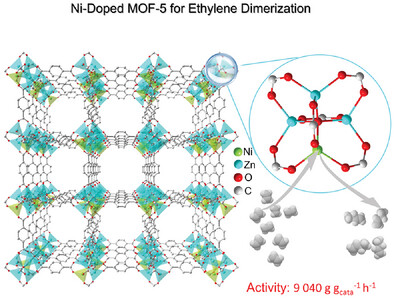
A series of Ni-doped MOF-5 heterogeneous catalysts are prepared via one-pot co-precipitation at room temperature. Owing to the high Ni loading and fully exposed structure, the Ni-doped MOF-5 shows a mass activity of 9040 grams of product per gram of catalyst per hour at 35 °C and 50 bar, far exceeding the activities of all reported heterogeneous catalysts.
Ultrathin Nitrogen-Doped Carbon Encapsulated Ni Nanoparticles for Highly Efficient Electrochemical CO2 Reduction and Aqueous Zn-CO2 Batteries
- First Published: 15 March 2023
High-Energy-Density Lithium Metal Batteries with Impressive Li+ Transport Dynamic and Wide-Temperature Performance from −60 to 60 °C
- First Published: 15 March 2023
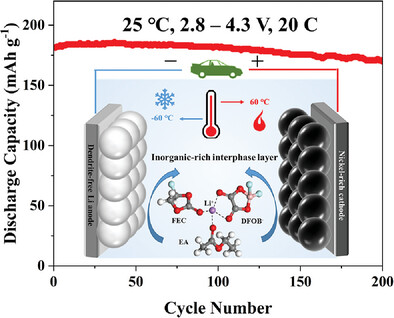
A superior electrolyte is fabricated by dissolving 2.4 m LiDFOB in EA and FEC. Owing to low viscosity, high dielectric constant, and the unique solvation structure, the electrolyte exhibits good interfacial stability with electrodes and fast Li+ transport dynamic. Hence, the NCM90/Li LMB shows excellent rate capability, impressive ultra-low-temperature performance, and wide-temperature applicability from −60 to 60 °C.
Superior Thermoelectric Properties of Twist-Angle Superlattice Borophene Induced by Interlayer Electrons Transport
- First Published: 15 March 2023
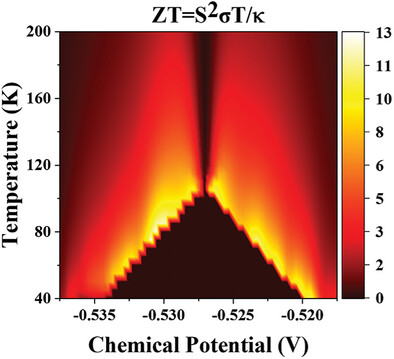
Superior thermoelectric properties of twist-angle superlattice borophene induced by interlayer electrons transport is manifested by the large Seebeck coefficient and figure of merit (ZT). The delocalization of electron and the localization of phonon can be simultaneously obtained by taking the advantage of the twist-angle superlattice, which result in larger electric conductivity and small thermal conductivity, and then the Superior figure of merit (ZT).
Oxygenated Triazine-Heptazine Heterostructure Creates an Enormous Ascension to the Visible Light Photocatalytic Hydrogen Evolution Performance of Porous C3N4 Nanosheets
- First Published: 15 March 2023
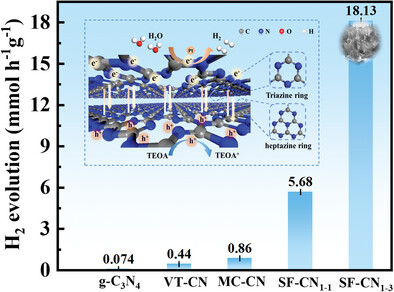
Porous g-C3N4 ultrathin nanosheets with a distinct intermolecular triazine-heptazine heterostructure have been judiciously developed via a facile one-pot thermal polymerization technique under a salt fog environment of urea and mixed metal salts. Benefitting from the unique structural merits, the resulting g-C3N4 photocatalyst demonstrates a very high-efficient visible light hydrogen production activity.
Coupling of Oxygen Vacancies and Heterostructure on Fe3O4 via an Anion Doping Strategy to Boost Catalytic Activity for Lithium-Sulfur Batteries
- First Published: 16 March 2023

Oxygen vacancy-enriched Fe3O4−x/FeP heterostructure embedded on NCT skeletons through a self-template method as an efficient sulfur host is designed and applied to trap and catalytic conversion of polysulfides. The polar Fe3O4−x/FeP heterostructure to polysulfides affords strong adsorption-catalyze reaction interfaces at an interfacial scale, which dynamically accelerates the rate capacity and cycling stability for advanced Li−S batteries.
Atomically Dispersed Fe/N4 and Ni/N4 Sites on Separate-Sides of Porous Carbon Nanosheets with Janus Structure for Selective Oxygen Electrocatalysis
- First Published: 16 March 2023
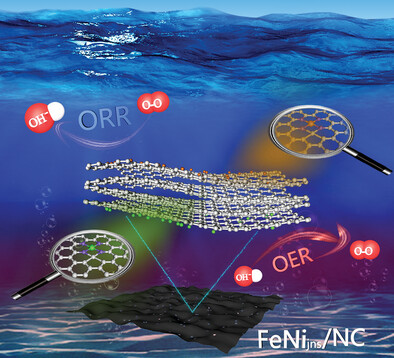
Atomically dispersed Fe/N4 and Ni/N4 sites anchoring on separate-sides of the carbon nanosheets with Janus structure (FeNijns/NC) is synthesized. Such structure can balance the competition of rate-limiting steps during oxygen reduction reaction (ORR) and oxygen evolution reaction (OER). FeNijns/NC has excellent ORR and OER bifunctional activities and Zn–air battery performances.
An Ion-Engineering Strategy to Design Hollow FeCo/CoFe2O4 Microspheres for High-Performance Microwave Absorption
- First Published: 17 March 2023
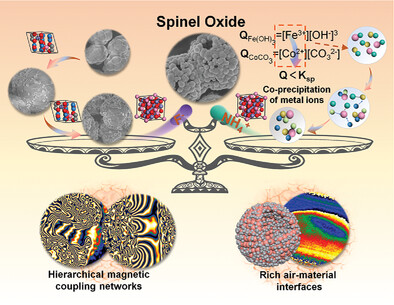
Assembled hollow CoFe2O4 microspheres are successfully constructed by an original bi-ions regulation strategy, meanwhile, the basic structure is perfectly retained after heat treatment. The multiscale magnetic coupling network and rich air-material interfaces contributing to the excellent microwave-absorption performance are confirmed through off-axis electron holography technique.
Ho-Ion-Polymer/Graphene Heterojunctions Toward Room-Temperature Ferromagnets
- First Published: 16 March 2023
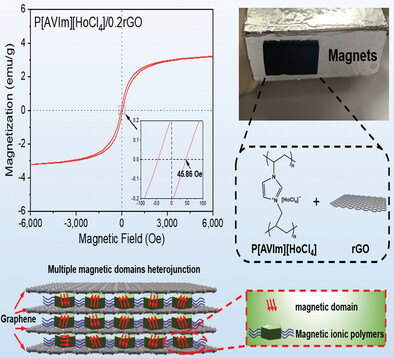
Owing to the structural restriction and charge exchange of Ho ion by polymer/graphene π–π stacking heterojunctions, holmium ion polymer composites exhibit typical S-shaped and are saturated from –6000 to 6000 Oe at room temperature. The room-temperature ferromagnetic ion polymer composite presents the highest saturation magnetization value of 3.36 emu g–1 compared to reported room-temperature organic ferromagnetic materials.
Nanoscale Control of the Surface Functionality of Polymeric 2D Materials
- First Published: 17 March 2023

By means of controlled, sequential polymer crystallization of two different, precisely synthesized polymers, locally structured nanosheets can be generated. The functional groups incorporated into the polymer chain arrange themselves in a core–shell morphology on the surface of a lamellar polymer crystal. The result is a nanosheet with different surface chemistry in the center and at the edge.
Switchable Polar Nanotexture in Nanolaminates HfO2-ZrO2 for Ultrafast Logic-in-Memory Operations
- First Published: 17 March 2023
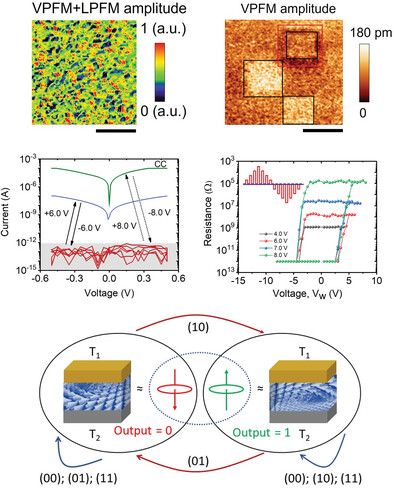
Logic-in-memory “processing with polar textures” at room temperature in HfO2-ZrO2 nanolaminates are demonstrated along with 14 Boolean logic operations. Utilizing local probe force microscopy, microscopic evidence of electric field switchable polar nanotexture is provided, which is used to design ultrafast (≈83 ns) nonvolatile multilevel memory with high on/off ratio (>106), long-term durability (>4000 s), and giant tunnel electroresistance (108%).
Multifunctional Resonance Bridge-Mediated Dynamic Modulation of Perovskite Films For Enhanced Intrinsic Stability of Photovoltaics
- First Published: 17 March 2023
Promising Mass-Productive 4-Inch Commercial SERS Sensor with Particle in Micro-Nano Porous Ag/Si/Ag Structure Using in Auxiliary Diagnosis of Early Lung Cancer
- First Published: 18 March 2023
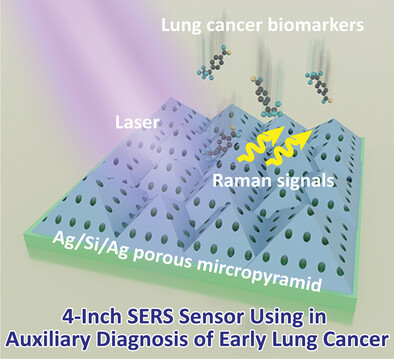
To construct a commercial surface enhanced Raman scattering (SERS) sensor suitable for clinical diagnosis of early lung cancer, herein, a promising mass-productive 4-inch ultrasensitive SERS substrate with a special architecture of particle in micro-nano porous structure is proposed and researched in detail, which suggests high-specificity recognition for lung cancer biomarker in exhalation tests.
Improving Out-of-Plane Charge Mobility and Phase Stability of Dion-Jacobson Lead-Free Perovskites via Intercalating π-Conjugated Aromatic Spacers
- First Published: 18 March 2023
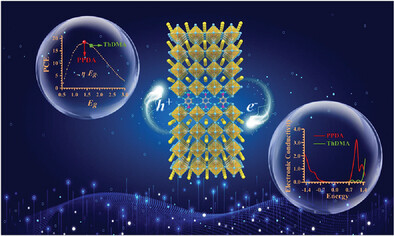
The photoelectric conversion efficiency (PCE) of (PPDA)Cs3Sn4I13 solar cell is calculated to be 18.52%, as a result of the optimal Eg, smaller carrier effective mass as well as the boosted charge transport. Meanwhile, the destruction of perovskite structure can promisingly be suppressed owing to the enhanced chemical bonding interactions. Thus, (PPDA)Cs3Sn4I13 perovskite exhibit enhanced structural stability and PCE.
Improved Thermal Stability and Film Uniformity of Halide Perovskite by Confinement Effect brought by Polymer Chains of Polyvinyl Pyrrolidone
- First Published: 17 March 2023
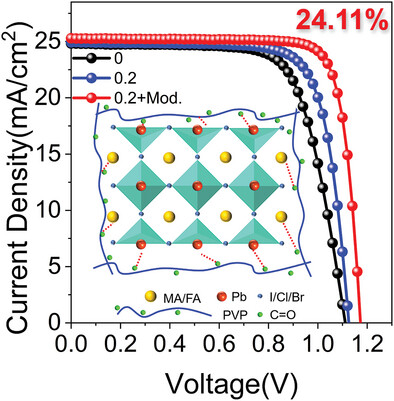
Polyvinyl pyrrolidone (PVP) is doped to PbI2 and organic salt, so as to regulate the crystallization process of halide perovskite. PVP doping can reduce crystallite size to a certain extent, due to the confinement effect provided by the long polymer chains of PVP. Interestingly, such an effect is helpful for both efficiency and stability (especially the thermal stability) of perovskite solar cells.
Sulfur-Induced Low Crystallization of Ultrathin Pd Nanosheet Arrays for Sulfur Ion Degradation-Assisted Energy-Efficient H2 Production
- First Published: 17 March 2023
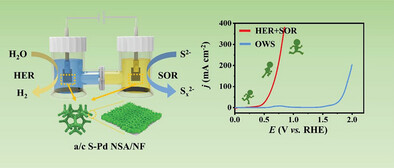
Amorphous/crystalline S-doped Pd nanosheet arrays on nickel foam (a/c S-Pd NSA/NF) is synthesized via an ambient immersion strategy. Benefiting from the ultrathin amorphous nanosheet structure and the incorporation of S atoms, the coupling system of a/c S-Pd NSA/NF can reach a current density of 100 mA cm−2 at 0.642 V lower than conventional electrolytic water by, greatly reducing energy consumption.
High Performance Inverted RbCsFAPbI3 Perovskite Solar Cells Based on Interface Engineering and Defects Passivation
- First Published: 17 March 2023
Hydroxyapatite-Derived Heterogeneous Ru-Ru2P Electrocatalyst and Environmentally-Friendly Membrane Electrode toward Efficient Alkaline Electrolyzer
- First Published: 17 March 2023
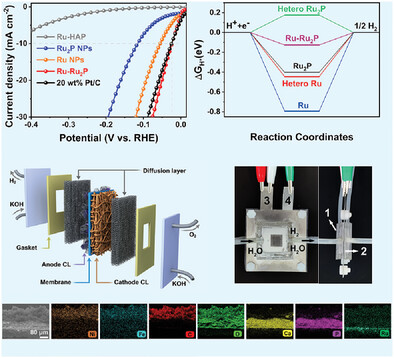
Ru-Ru2P heterogeneous nanoparticles are synthesized via an environmentally friendly in situ green phosphating strategy. The strong electronic redistribution occurs at the heterointerface of Ru-Ru2P, leading to accelerated hydrogen adsorption/desorption kinetics and possessing excellent hydrogen evolution reaction performance. Hydroxyapatite nanowires are used as alkaline membranes to assemble environmentally friendly membrane electrodes with a sandwich structure for use in the alkaline electrolyzer.
Understanding the Role of (W, Mo, Sb) Dopants in the Catalyst Evolution and Activity Enhancement of Co3O4 during Water Electrolysis via In Situ Spectroelectrochemical Techniques
- First Published: 18 March 2023
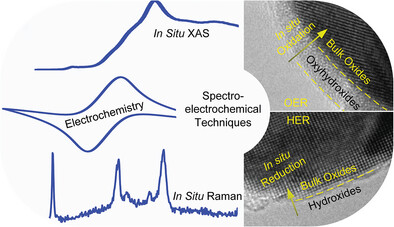
In this article, the authors study the transformation of the doped Co3O4 during the oxygen and hydrogen evolution reactions using in situ spectroelectrochemical techniques such as in situ X-ray absorption and Raman spectroscopies. They reveal that the dopants (W, Mo, Sb) improve the bulk conductivity and density of redox active sites but do not alter the reaction mechanisms.
Scalable Manufacturing of Environmentally Stable All-Solid-State Plant Protein-Based Supercapacitors with Optimal Balance of Capacitive Performance and Mechanically Robust
- First Published: 18 March 2023
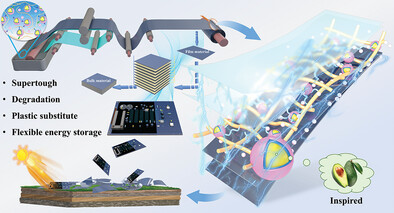
Herein, a mechanically robust, fatigue-resistance, and degradable film biomaterial has been fabricated in a green and scalable way for plastic substitute. Furthermore, the film material combines by stacking-up and hot-pressing techniques to construct an ordered, dense bulk material supercapacitor, which shows an ultrahigh energy density of 25.8 Wh kg−1 and high dielectric constant across a broad temperature range.
Multifunctional Nanocrystalline-Assembled Porous Hierarchical Material and Device for Integrating Microwave Absorption, Electromagnetic Interference Shielding, and Energy Storage
- First Published: 18 March 2023
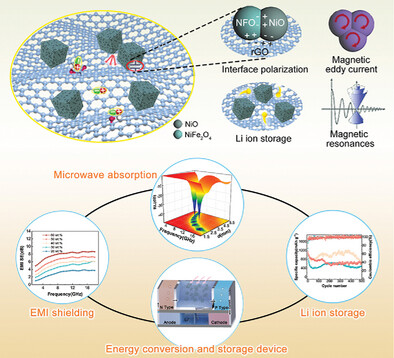
Owing to structural and compositional advantages, the novel nanocrystalline-assembled porous hierarchical NiO@NiFe2O4/reduced graphene oxide heterostructure achieves excellent microwave absorption, electromagnetic interference shielding, as well as fast and long-cycle stable Li ion storage performances. A novel self-powered device is designed to convert EM energy into electric energy to charge Li-ion batteries, opening the perspective of future integrated energy conversion system.
Synergistic Functionality of Dopants and Defects in Co-Phthalocyanine/B-CN Z-Scheme Photocatalysts for Promoting Photocatalytic CO2 Reduction Reactions
- First Published: 19 March 2023
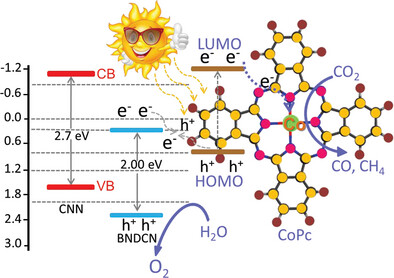
The BNDCN material has remarkably improved photocatalytic CO2 RR activity due to its CB and VB positions being expertly modulated to create ideal band structures for CO2 RR driving force and visible light absorption. The material's designed electronic architecture includes abundant unsaturated sites and strong interlayer CN interaction, which result in efficient electron excitation and accelerated charge transfer kinetics.
In Situ Detecting Thermal Stability of Solid Electrolyte Interphase (SEI)
- First Published: 17 March 2023
Enzyme-Triggered Transforming of Assembly Peptide-Modified Magnetic Resonance-Tuned Probe for Highly Sensitive Imaging of Bacterial Infection In Vivo
- First Published: 17 March 2023

The enzyme-responsive magnetic resonance tuning (MRET) probe (MPD-1), composed of the targeting peptide (P), superparamagnetic quencher of magnetic nanoparticle (MNP) monomer, and paramagnetic enhancer peptide (P1), is triggered to disassembly by matrix metallopeptidase 2 (MMP-2) highly expressed in the bacteria-infected microenvironment, leading the increase of T1-weighted signal. Based on the MPD-1 probe, precise and sensitive detection of Staphylococcus aureus infection in vivo is achieved.
A Self-Disguised Nanospy for Improving Drug Delivery Efficiency via Decreasing Drug Protonation
- First Published: 17 March 2023
Defect-Rich PdIr Bimetallene Nanoribbons with Interatomic Charge Localization for Isopropanol-Assisted Seawater Splitting
- First Published: 18 March 2023
Carbon Foam-Supported VS2 Cathode for High-Performance Flexible Self-Healing Quasi-Solid-State Zinc-Ion Batteries
- First Published: 17 March 2023
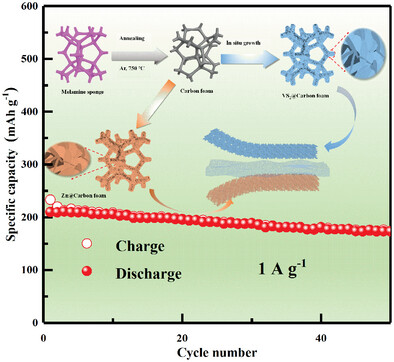
A flexible VS2@CF cathode is successfully fabricated by hydrothermal method and the aggregation between VS2 nanosheets is greatly reduced by the introduction of carbon foam substrate, and a self-healing gel is used as the electrolyte of the flexible quasi-solid-state zinc ion batteries (QZIBs). The VS2@CF//Zn@CF flexible self-healing QZIBs show good flexible and self-healing properties.
Optimizing d-Orbital Electronic Configuration via Metal–Metal Oxide Core–Shell Charge Donation for Boosting Reversible Oxygen Electrocatalysis
- First Published: 18 March 2023
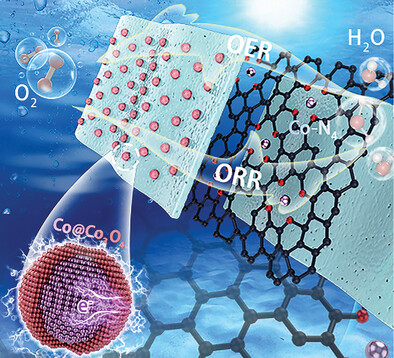
A well-defined core–shell Co@Co3O4 embedded in Co, N co-doped porous carbon derived from thickness controlled 2D MOF is designed. The electrons donation of Co core into Co3O4 shell downshift the d-band center and simultaneously weak spin state of Co3O4, leading to optimized adsorption energies of oxygen intermediates, thus improve the ORR/OER bifunctional catalysis activity of Co3O4 shell.
Self-Assembled Tetratic Crystals by Orthogonal Colloidal Force
- First Published: 18 March 2023
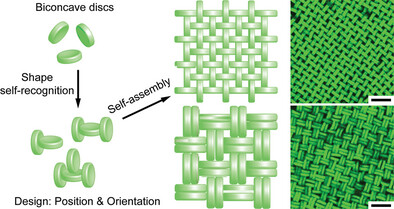
A shape self-recognition route is presented, which can control both the position and the orientation of particles during self-assembly by directional colloidal forces. An unusual but very challenging open superstructure—tetratic crystal (TC)—is achieved. Using the finite difference time domain method, binary TCs with intriguing photonic crystal properties of modulating the polarization state of lights are demonstrated.
The Role of Interfacial Water in CO2 Electrolysis over Ni-N-C Catalyst in a Membrane Electrode Assembly Electrolyzer
- First Published: 18 March 2023
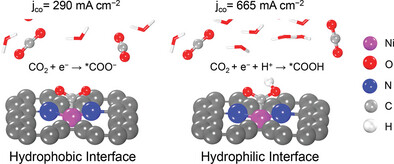
The hydrophilic electrocatalytic interface built by modifying Ni-N-C catalyst with quaternary ammonia poly(N-methyl-piperidine-co-p-terphenyl) promotes the formation of the *COOH intermediate and achieves a high CO partial current density of 665 mA cm−2 in a membrane electrode assembly (MEA) electrolyzer.
Editor's Choice
One-Dimensional Chiral Copper Iodide Chain-Like Structure Cu4I4(R/S-3-quinuclidinol)3 with Near-Unity Photoluminescence Quantum Yield and Efficient Circularly Polarized Luminescence
- First Published: 18 March 2023
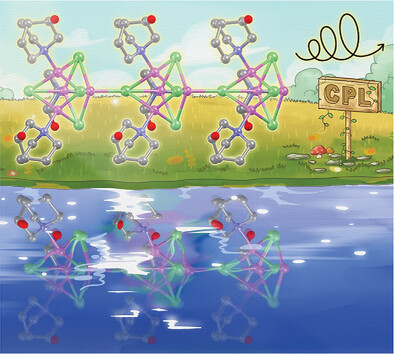
Incorporating chiral organic ligands with high steric hindrance into highly intense luminescent inorganic Cu4I4 cubane nanoclusters, results in a formation of new 1D chain-like structure. The rigid and chiral structure leads to a near-unity photoluminescence quantum yield (PLQY) and effective circularly polarized luminescence at room temperature.
Imparting Outstanding Dispersibility to Nanoscaled 2D COFs for Constructing Organic Solvent Forward Osmosis Membranes
- First Published: 18 March 2023
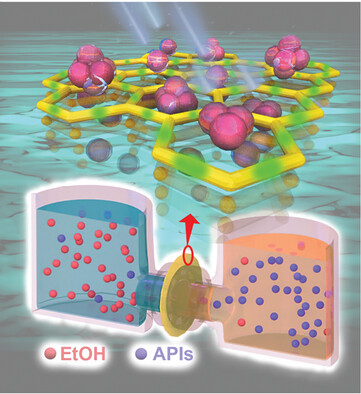
Covalent organic framework (COF) nanoparticles with abundant amine groups, good dispersity and homogeneous morphology are synthesized. The as-prepared COFs are utilized to modify the physicochemical characteristics of the polyamide (PA) network. The resultant thin-film nanocomposite membranes, comprising an interlayer of COF nanoparticles and a top skin of PA layer, achieve high recycling ability for pharmaceutical synthetic organic solvents.
Development of a ZIF-91-Porous-Liquid-Based Composite Hydrogel Dressing System for Diabetic Wound Healing
- First Published: 18 March 2023
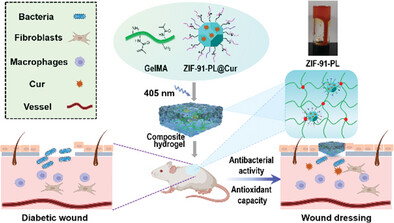
A ZIF-based porous liquid (ZIF-91-PL) and its composite hydrogel are proposed to improve curcumin (Cur) loading capacity and sustained release. Biological studies demonstrate that the ZIF-91-PL@Cur-based hydrogel is an ideal wound dressing material with superior antibacterial and antioxidant capacity. Animal experiments confirm its excellent healing effect on diabetic wounds.
Cation–π Interaction Trigger Supramolecular Hydrogelation of Peptide Amphiphiles
- First Published: 18 March 2023

The introduction of cation–π interaction pair into peptide amphiphile triggers peptide conformation change from random coil to β-hairpin structure, ultimately leads to the formation of fibril-rich hydrogel. As the first case of using cation–π interactions to trigger peptide folding, this work provides a novel strategy to generate supramolecular biomaterials.
Thyroid-Friendly Soft Materials as 3D Cell Culture Tool for Stimulating Thyroid Cell Function
- First Published: 18 March 2023
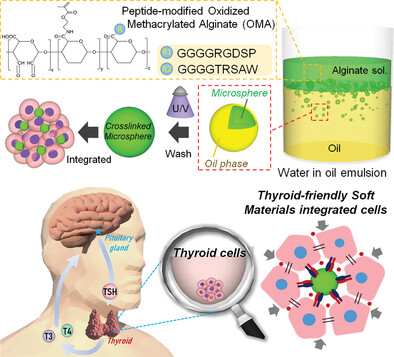
Thyroid-cell-friendly peptides and soft microspheres can be used to efficiently culture 3D thyroid cells in vitro. Thus, these peptide-modified microspheres can serve as the starting point for the development of tools for controlling cell functions in the desired direction and evaluating the efficacy and toxicity of various chemicals.
Learning and Predicting Photonic Responses of Plasmonic Nanoparticle Assemblies via Dual Variational Autoencoders
- First Published: 21 March 2023
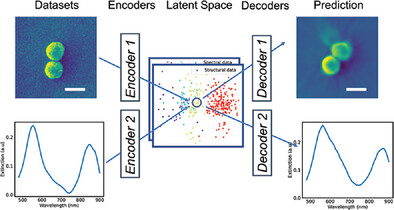
The application of machine learning is demonstrated for rapid and accurate extraction of plasmonic particles cluster geometries from hyperspectral image data via a dual variational autoencoder (dual-VAE). In this approach, the information is shared between the latent spaces of two VAEs acting on the particle shape data and spectral data, respectively, but enforcing a common encoding on the shape-spectra pairs.
Cell-Derived Vesicles for Antibiotic Delivery—Understanding the Challenges of a Biogenic Carrier System
- First Published: 20 March 2023
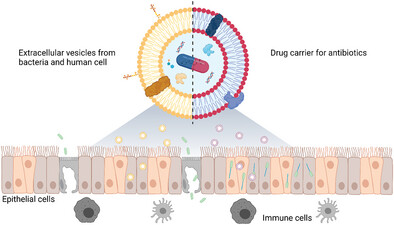
Extracellular vesicles from bacteria and human cells are loaded with antimicrobial ciprofloxacin and studied in complex in vitro and in vivo models. Different encapsulation techniques are assessed, including saponin treatment and electroporation. The incorporation of ciprofloxacin into vesicles augmented the biocompatibility of the drug in a zebrafish larvae model. This study provides a relevant basis to understand biogenic drug avenues.
A Cascade Enzyme System Integrating Peroxidase Mimic with Catalase for Linear Range Expansion of H2O2 Assay: A Mechanism and Application Study
- First Published: 27 March 2023
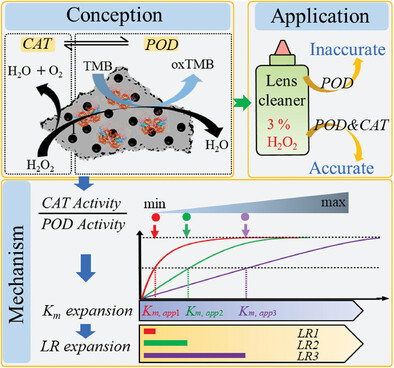
A cascade enzyme system (rGRC) integrating peroxidase with catalase is constructed. Then, it is theoretically expected and experimentally confirmed that increasing relative activity between CAT and POD can result in Km increase of POD and LR expansion for H2O2 assay. At last, rGRC is demonstrated to detect high concentration of H2O2 in contact lens cleaner more accurately than conventional peroxidase.
Crystals of Aliphatic Derivatives of [Cu(acac)2] have Distinct Atomic-Scale Mechanisms of Bending
- First Published: 18 March 2023




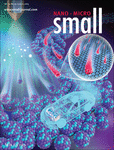
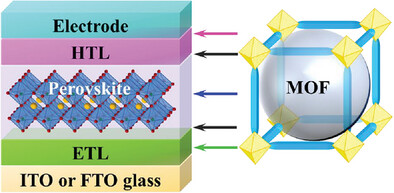
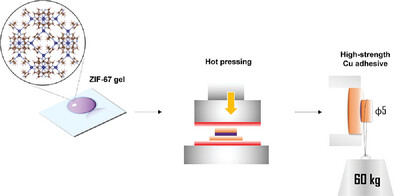
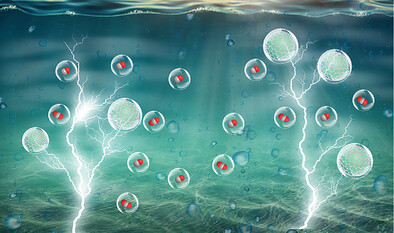
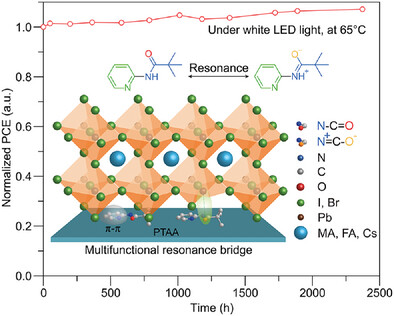

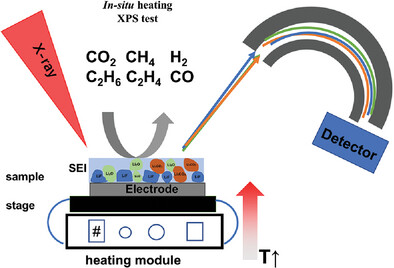
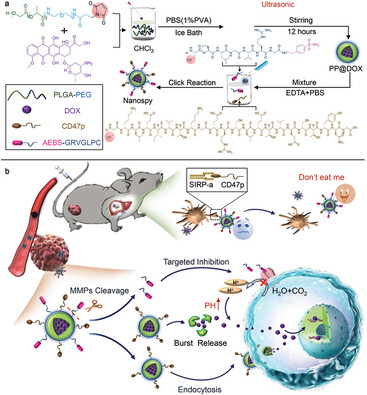
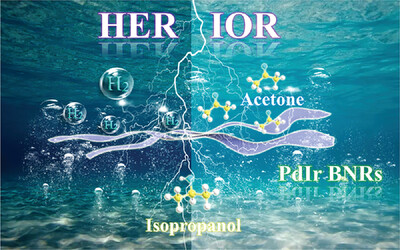
![Crystals of Aliphatic Derivatives of [Cu(acac)2] have Distinct Atomic-Scale Mechanisms of Bending](/cms/asset/5e57acef-b36a-4146-94fc-e09364768f09/smll202207431-gra-0001-m.jpg)
